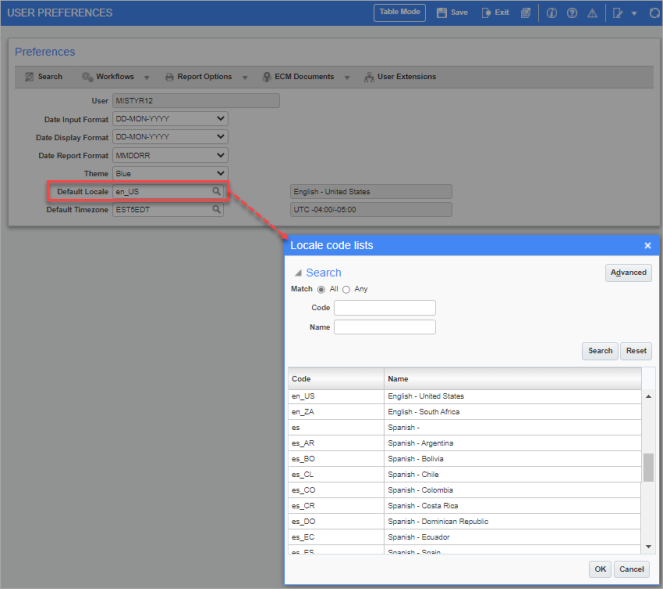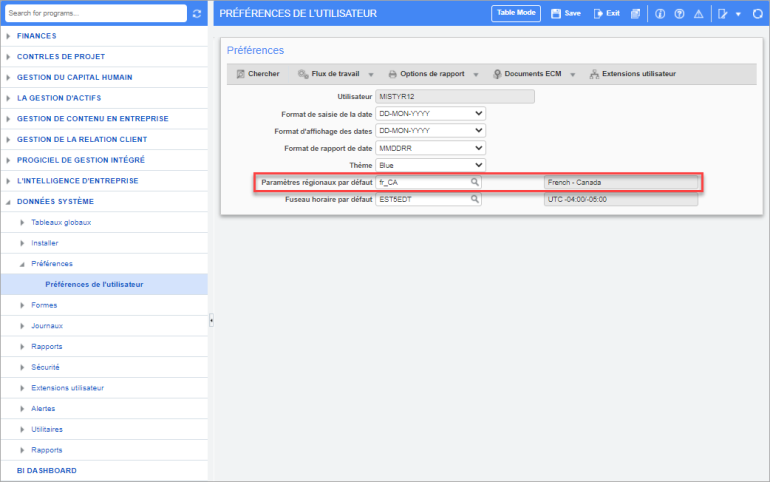
Pgm: SDUPREF –User Preferences; standard Treeview path: System > Preferences > User Preferences - Log
Once a user ID has been set up, this screen is used to define the preferences which will distinguish that user.
If you have the security privilege to create/modify users or you have entered this screen as “DA”, a list of users will be displayed, as shown in the log above. Otherwise, if this screen is being used by any other user, the system will limit access to only the current User record.
NOTE: The user "DA" applies to Enterprise environments only and does not apply to Cloud customers. The preferences set on user “DA” for date formats and colors will automatically default to all users. Therefore, before setting up any users other than “DA”, it is best to ensure that “DA” has these corporate defaults set.

Pgm: SDUPREF – User Preferences; standard Treeview path: System > Preferences > User Preferences
The screenshot above shows an example of a selected user's preferences. Lite Editor can be used to add additional available fields, as required (e.g., Preferred Report Engine).
User
The user ID for which preferences are being defined.
Date Input Format
The format specified in the Date Input Format field defines the way in which this user can enter dates in the screens.
Date Display Format
The format specified in the Date Display Format field defines the way in which this user will see the dates displayed in screens.
Date Report Format
The format specified in the Date Report Format field defines the way in which reports printed by this user will display dates.
Theme
The Theme field defines the console theme for this user. A default theme may have already been set at the system level on the System Options screen (standard Treeview path: System > Setup > System Options – Global tab), but it can be changed here at the user level. A theme selected here also defaults into the Theme field in the Defaults tab of the User Settings pop-up window launched from the username link on the UI Console.
Default Locale

Pop-up window launched from Default Local field
This field is used to define the display language for ADF software screens (i.e. UIRuntime, UIConsole, etc.).

User Settings pop-up window launched from console
The default display language can also be set in the User Settings pop-up window launched from the user’s console.

Example of Default Locale Set to French - Canada
When a new default language is applied, the screen will need to be refreshed to see the updated default language displayed. The screenshot above shows an example of the Default Locale field set to "fr_CA" which switches the display language to "French - Canada" (i.e. the base language is French and the locale is Canada). The text in the Treeview menu and the screen is displayed in French.
NOTE: Currently, not all screens support French and Spanish as display languages (e.g. JSP).
In addition to determining the display language, the Default Locale field is also used in conjunction with the Default Timezone field to define how Jasper Reports display local date and time for the currently selected user.
Default Timezone
The Default Locale and Default Timezone fields define the way in which Jasper Reports printed by this user will display the local date and time.
[Reset All Users' Time Zones] – Button
Press this button to reset the time zone for all users to match the currently selected user's default time zone.
NOTE: This button is only enabled for users with the system privilege 'SYSUSRCRE – SD: Allows the user to change preferences of other users'. For more information, please refer to Define Roles.